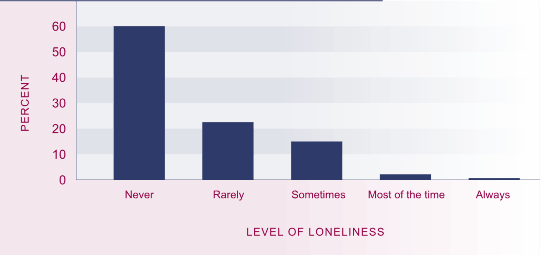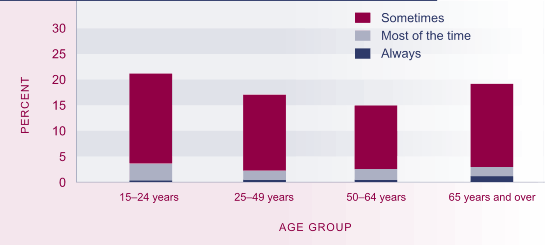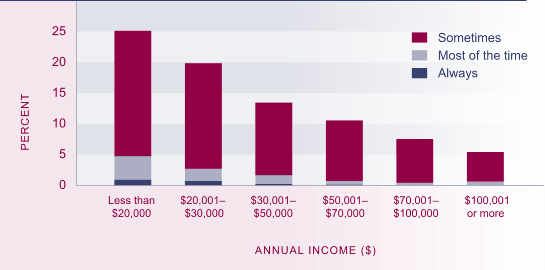Loneliness
Definition
The proportion of people aged 15 and over who reported feeling lonely "sometimes", "most of the time", or "always" during the previous 12 months, as reported in the Quality of Life in New Zealand 's Largest Cities Survey 2004.
Relevance
Social contact is of fundamental importance to people: humans are social creatures. Self-assessed loneliness is a proxy indicator of whether people are happy with the amount and quality of social contact they get. As well as being an undesirable state in itself, loneliness may also contribute to poor outcomes in other areas, including adverse health problems such as stress, anxiety or depression.
Current level
In 2004, 18 percent of New Zealanders reported having felt lonely over the last 12 months. Fifteen percent said they felt lonely "sometimes", while a small group of people reported feeling lonely more frequently. Two percent said they were lonely "most of the time" and fewer than 1 percent said they "always" feel lonely. Unemployed people and people without a partner were more likely than New Zealanders as a whole to report feeling lonely (31 percent and 32 percent respectively).
Figure SC4.1 Proportion of people experiencing loneliness, 2004

Source: Auckland City Council et al (2005) Quality of Life in New Zealand's Largest Cities
Sex differences
Overall, females (20 percent) were more likely to report having felt lonely "sometimes", "most of the time", or "all of the time" in the last 12 months than males (15 percent). Seventeen percent of females said they were "sometimes" lonely compared to 13 percent of males.
Age differences
Loneliness is most prevalent among those aged 15–24 years, followed by people aged 65 and over: 21 percent of people aged 15–24 and 19 percent of those aged 65 and over experienced feelings of loneliness "sometimes", "most of the time", or "always". Levels of loneliness were somewhat lower among those aged 25–49 (17 percent) and lowest among 50–64 year olds (15 percent).
Figure SC4.2 Proportion of people experiencing loneliness, by age, 2004

Source: Auckland City Council et al (2005) Quality of Life in New Zealand's Largest Cities
Ethnic differences
Europeans reported the lowest rate of loneliness with 15 percent reporting they are lonely "sometimes", "most of the time", or "always". Twenty-two percent of Māori and 25 percent of Pacific peoples reported they are "sometimes", "most of the time", or "always" lonely. Asian/Indian peoples (36 percent) and people in "Other" ethnic groups (36 percent) reported the highest rates of loneliness.
Personal income differences
Experiencing loneliness declines as personal income rises. People with personal incomes of $20,000 or less reported higher rates of loneliness than people with higher incomes: 25 percent said they felt lonely "sometimes", "most of the time", or "always" in the past 12 months. This compares with a loneliness rate of only 5 percent for those with a personal income over $100,001.
Figure SC4.3 Proportion of people experiencing loneliness, by personal income, 2004

Source: Auckland City Council et al (2005) Quality of Life in New Zealand's Largest Cities
Regional differences
People living in Manukau City had the highest reported incidence of loneliness with 21 percent reporting they felt lonely "always", "most of the time", or "sometimes". Those living in the Rodney District had the lowest reported incidence of experiencing loneliness (14 percent).
|



